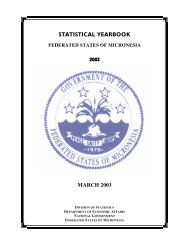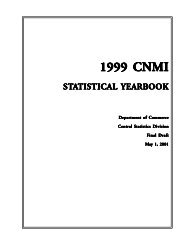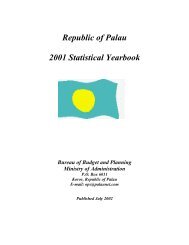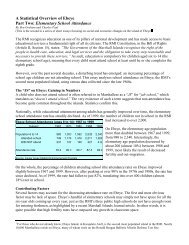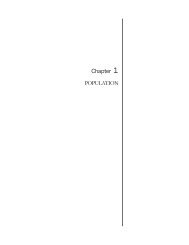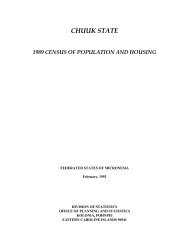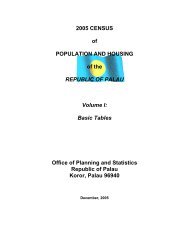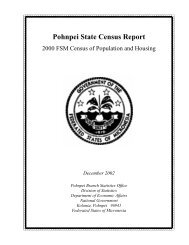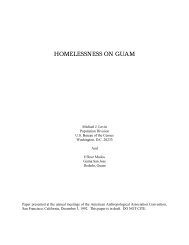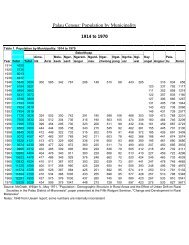- Page 5: iii
- Page 12 and 13: Preface2000 FSM Census of Chuukx
- Page 14 and 15: Table of contents2000 FSM Census of
- Page 16 and 17: LIST OF TEXT TABLESTABLEPageChapter
- Page 18 and 19: List of Text Table2000 FSM Census o
- Page 20 and 21: LIST OF FIGURESFIGUREPageFigure 1.1
- Page 22 and 23: List of Basic-Tables2000 FSM Census
- Page 24 and 25: MAP OF FSMxxiiChuuk Branch Statisti
- Page 27 and 28: 2000 FSM Census of Chuuk StateExecu
- Page 29 and 30: CHAPTER 1INTRODUCTIONThe creation o
- Page 31 and 32: 2000 FSM Census of Chuuk StateChapt
- Page 33 and 34: 2000 FSM Census of Chuuk StateChapt
- Page 35 and 36: 2000 FSM Census of Chuuk StateChapt
- Page 37 and 38: 2000 FSM Census of Chuuk StateChapt
- Page 39 and 40: 2000 FSM Census of Chuuk StateChapt
- Page 41 and 42: 2000 FSM Census of Chuuk StateChapt
- Page 43 and 44: 2000 FSM Census of Chuuk State Chap
- Page 45: 2000 FSM Census of Chuuk StateChapt
- Page 49 and 50: 2000 FSM Census of Chuuk StateChapt
- Page 51 and 52: 2000 FSM Census of Chuuk StateChapt
- Page 53: 2000 FSM Census of Chuuk StateChapt
- Page 56 and 57: Chapter 3. Households, Families, an
- Page 58 and 59: Chapter 3. Households, Families, an
- Page 60 and 61: Chapter 3. Households, Families, an
- Page 63 and 64: CHAPTER 4FERTILITYIntroductionBefor
- Page 65 and 66: 2000 FSM Census of Chuuk StateChapt
- Page 67 and 68: 2000 FSM Census of Chuuk StateChapt
- Page 69: 2000 FSM Census of Chuuk StateChapt
- Page 72 and 73: Chapter 5. Mortality2000 FSM Census
- Page 74 and 75: Chapter 5. Mortality2000 FSM Census
- Page 77 and 78: CHAPTER 6MIGRATIONIntroductionIn pr
- Page 79 and 80: 2000 FSM Census of Chuuk StateChapt
- Page 81 and 82: 2000 FSM Census of Chuuk StateChapt
- Page 83 and 84: 2000 FSM Census of Chuuk StateChapt
- Page 85 and 86: CHAPTER 7RELIGION, ETHNICITY AND LA
- Page 87 and 88: 2000 FSM Census of Chuuk StateChapt
- Page 89 and 90: 2000 FSM Census of Chuuk StateChapt
- Page 91 and 92: CHAPTER 8EDUCATION AND LITERACYIntr
- Page 93 and 94: 2000 FSM Census of Chuuk StateChapt
- Page 95 and 96: 2000 FSM Census of Chuuk StateChapt
- Page 97 and 98:
2000 FSM Census of Chuuk StateChapt
- Page 99 and 100:
2000 FSM Census of Chuuk StateChapt
- Page 101:
2000 FSM Census of Chuuk StateChapt
- Page 104 and 105:
Chapter 9. Economic Activity2000 FS
- Page 106 and 107:
Chapter 9. Economic Activity2000 FS
- Page 108 and 109:
Chapter 9. Economic Activity2000 FS
- Page 110 and 111:
Chapter 9. Economic Activity2000 FS
- Page 112 and 113:
Chapter 9. Economic Activity2000 FS
- Page 114 and 115:
Chapter 9. Economic Activity2000 FS
- Page 116 and 117:
Chapter 9. Economic Activity2000 FS
- Page 118 and 119:
Chapter 10. Industry and Occupation
- Page 120 and 121:
Chapter 10. Industry and Occupation
- Page 122 and 123:
Chapter 10. Industry and Occupation
- Page 124 and 125:
Chapter 10. Industry and Occupation
- Page 126 and 127:
Chapter 10. Industry and Occupation
- Page 128 and 129:
Chapter 10. Industry and Occupation
- Page 130 and 131:
Chapter 11. Income2000 FSM Census o
- Page 132 and 133:
Chapter 11. Income2000 FSM Census o
- Page 134 and 135:
Chapter 11. Income2000 FSM Census o
- Page 136 and 137:
Chapter 11. Income2000 FSM Census o
- Page 139 and 140:
CHAPTER 12HOUSING CHARACTERISTICSIn
- Page 141 and 142:
2000 FSM Census of Chuuk StateChapt
- Page 143 and 144:
2000 FSM Census of Chuuk StateChapt
- Page 145 and 146:
2000 FSM Census of Chuuk StateChapt
- Page 147 and 148:
2000 FSM Census of Chuuk StateChapt
- Page 149 and 150:
2000 FSM Census of Chuuk StateChapt
- Page 151 and 152:
2000 FSM Census of Chuuk StateChapt
- Page 153 and 154:
2000 FSM Census of Chuuk StateChapt
- Page 156 and 157:
Chapter 12. Housing2000 FSM Census
- Page 158 and 159:
Bibliography2000 FSM Census of Chuu
- Page 161 and 162:
APPENDIX ABASIC TABLESTable B01a. A
- Page 163 and 164:
2000 FSM Census of Chuuk StateBasic
- Page 165 and 166:
2000 FSM Census of Chuuk StateBasic
- Page 167 and 168:
2000 FSM Census of Chuuk StateBasic
- Page 169 and 170:
2000 FSM Census of Chuuk StateBasic
- Page 171 and 172:
2000 FSM Census of Chuuk StateBasic
- Page 173 and 174:
2000 FSM Census of Chuuk StateBasic
- Page 175 and 176:
2000 FSM Census of Chuuk StateBasic
- Page 177 and 178:
2000 FSM Census of Chuuk StateBasic
- Page 179 and 180:
2000 FSM Census of Chuuk StateBasic
- Page 181 and 182:
2000 FSM Census of Chuuk StateBasic
- Page 183 and 184:
2000 FSM Census of Chuuk StateBasic
- Page 185 and 186:
2000 FSM Census of Chuuk StateBasic
- Page 187 and 188:
2000 FSM Census of Chuuk StateBasic
- Page 189 and 190:
2000 FSM Census of Chuuk StateBasic
- Page 191 and 192:
2000 FSM Census of Chuuk StateBasic
- Page 193 and 194:
2000 FSM Census of Chuuk StateBasic
- Page 195 and 196:
2000 FSM Census of Chuuk StateBasic
- Page 197 and 198:
2000 FSM Census of Chuuk StateBasic
- Page 199 and 200:
2000 FSM Census of Chuuk StateBasic
- Page 201 and 202:
2000 FSM Census of Chuuk StateBasic
- Page 203 and 204:
2000 FSM Census of Chuuk StateBasic
- Page 205 and 206:
2000 FSM Census of Chuuk StateBasic
- Page 207 and 208:
2000 FSM Census of Chuuk StateBasic
- Page 209 and 210:
2000 FSM Census of Chuuk StateBasic
- Page 211 and 212:
2000 FSM Census of Chuuk StateBasic
- Page 213 and 214:
2000 FSM Census of Chuuk StateBasic
- Page 215 and 216:
2000 FSM Census of Chuuk StateBasic
- Page 217 and 218:
2000 FSM Census of Chuuk StateBasic
- Page 219 and 220:
2000 FSM Census of Chuuk StateBasic
- Page 221 and 222:
2000 FSM Census of Chuuk StateBasic
- Page 223 and 224:
2000 FSM Census of Chuuk StateBasic
- Page 225 and 226:
2000 FSM Census of Chuuk StateBasic
- Page 227 and 228:
2000 FSM Census of Chuuk StateBasic
- Page 229 and 230:
2000 FSM Census of Chuuk StateBasic
- Page 231 and 232:
2000 FSM Census of Chuuk State Basi
- Page 233 and 234:
2000 FSM Census of Chuuk StateBasic
- Page 235 and 236:
2000 FSM Census of Chuuk StateBasic
- Page 237 and 238:
2000 FSM Census of Chuuk StateBasic
- Page 239 and 240:
2000 FSM Census of Chuuk StateBasic
- Page 241 and 242:
2000 FSM Census of Chuuk StateBasic
- Page 243 and 244:
2000 FSM Census of Chuuk StateBasic
- Page 245 and 246:
2000 FSM Census of Chuuk StateBasic
- Page 247 and 248:
2000 FSM Census of Chuuk StateBasic
- Page 249 and 250:
2000 FSM Census of Chuuk StateBasic
- Page 251 and 252:
2000 FSM Census of Chuuk StateBasic
- Page 253 and 254:
2000 FSM Census of Chuuk StateBasic
- Page 255 and 256:
2000 FSM Census of Chuuk StateBasic
- Page 257 and 258:
2000 FSM Census of Chuuk StateBasic
- Page 259 and 260:
2000 FSM Census of Chuuk StateBasic
- Page 261 and 262:
2000 FSM Census of Chuuk StateBasic
- Page 263 and 264:
2000 FSM Census of Chuuk StateBasic
- Page 265 and 266:
2000 FSM Census of Chuuk StateBasic
- Page 267 and 268:
2000 FSM Census of Chuuk StateBasic
- Page 269 and 270:
2000 FSM Census of Chuuk StateBasic
- Page 271 and 272:
2000 FSM Census of Chuuk StateBasic
- Page 273 and 274:
2000 FSM Census of Chuuk StateBasic
- Page 275 and 276:
2000 FSM Census of Chuuk StateBasic
- Page 277 and 278:
2000 FSM Census of Chuuk StateBasic
- Page 279 and 280:
2000 FSM Census of Chuuk StateBasic
- Page 281 and 282:
2000 FSM Census of Chuuk StateBasic
- Page 283 and 284:
2000 FSM Census of Chuuk StateBasic
- Page 285 and 286:
2000 FSM Census of Chuuk StateBasic
- Page 287 and 288:
2000 FSM Census of Chuuk StateBasic
- Page 289 and 290:
2000 FSM Census of Chuuk StateBasic
- Page 291 and 292:
APPENDIX BQUESTIONNAIREChuuk Branch
- Page 293 and 294:
2000 FSM Census of Chuuk StateQuest
- Page 295 and 296:
2000 FSM Census of Chuuk StateQuest
- Page 297:
2000 FSM Census of Chuuk StateQuest



